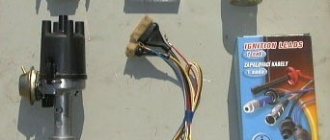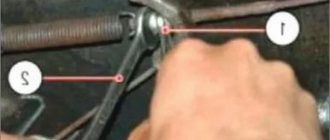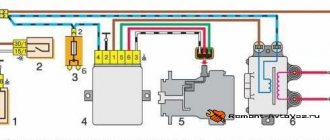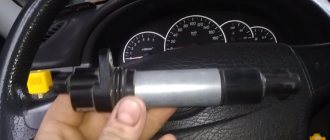Ignition system VAZ 2101
Classic Zhiguli models with carburetor engines are equipped with an ignition system that requires periodic adjustment. The efficiency and stable operation of the power unit depends on the correct setting of the ignition timing and the uninterrupted operation of this system. Since ignition adjustment is one of the most important measures for setting up an engine, it is worthwhile to dwell on this process, as well as on the constituent elements of the ignition system, in more detail.
What it is
The ignition system is a combination of several devices and devices that ensure sparking and further ignition of the combustible mixture in the engine cylinders at the right time. This system has several functions:
- The formation of a spark at the moment of compression of the piston, according to the order of operation of the cylinders.
- Ensuring timely ignition timing according to the optimal advance angle.
- Creation of such a spark as is necessary to ignite the fuel-air mixture.
- Continuous sparking.
Principle of spark formation
When the ignition is turned on, current begins to flow to the contacts of the distributor breaker. When starting the engine, the ignition distributor shaft rotates simultaneously with the crankshaft, which, with its cam, closes and opens the low voltage circuit. The pulses are supplied to the ignition coil, where the voltage is converted to high voltage, after which it is supplied to the central contact of the distributor. Then the voltage is distributed through the slider across the contacts of the cover and supplied to the spark plugs via explosive wires. In this way, a spark is formed and distributed.
Diagram of the VAZ 2101 ignition system: 1 - generator; 2 — ignition switch; 3 — ignition distributor; 4 — breaker cam; 5 — spark plugs; 6 — ignition coil; 7 - battery
Why is adjustment needed?
If the ignition is set incorrectly, many problems arise:
- power is lost;
- the motor is troublesome;
- fuel consumption increases;
- pops and shots appear in the silencer;
- unstable operation at idle, etc.
To avoid all of these difficulties, the ignition needs to be adjusted. Otherwise, normal operation of the vehicle will be impossible.
How to adjust the torque on a VAZ 2101 with your own hands?
After a new lock has been installed as a result of repair or replacement, it is imperative to set up and adjust the advance angle. Without this, the VAZ 2101 engine will not function correctly.
How to install by spark?
To set the ignition on a VAZ 2101 using the simplest method, you need to perform a series of sequential actions:
- The car's engine compartment opens.
- The crankshaft of the power unit is set to the required position according to the marks.
- The central cable is disconnected from the ignition distribution device (distributor). Its contact must be fixed at a distance of about 5 mm from the mass of the car. To do this, you can use the car body or the cylinder head.
- Then the screw that secures the distribution assembly housing is loosened. The ignition is activated.
- The distributor housing rotates clockwise approximately 10-20 degrees.
- After this, it must be turned in the opposite direction. The turning procedure is carried out until a spark appears between the tip of the distributor and the ground. If this happens, the distribution unit is fixed by tightening the bolt.
The “Auto Repair and Maintenance” channel spoke about the nuances of adjusting the ignition angle by spark.
How to adjust the timing using a light bulb?
Before setting up and adjusting the ignition, you need to make sure that the spark plugs are working, otherwise there is no point in carrying out this task.
There should be no carbon deposits on these elements. If it is present, the devices are removed and cleaned; for this you can use an iron brush or special means. Before starting work, you need to find the marks located on the crankshaft, as well as the chain drive pulley, they are cleaned.
The adjustment procedure looks like this:
- First, the crankshaft is rotated so that the mark aligns with the mark on the chain drive housing. If the vehicle is equipped with an engine in which the cylinder diameter is 7.9 cm, then the mark on the shaft must be placed opposite the middle one located on the chain drive. If the size of the cylindrical elements on the car is 7.6 cm, then the mark is aligned with the outermost mark on the cover. This action will allow you to set the engine crankshaft to the top dead center position.
- After aligning the marks, the wire that goes from the ignition coil to the distribution mechanism is disconnected. It must be disconnected directly from the clamp on the distributor. After this, a conductor from a light source is connected to it, which will be used as an adjusting element.
- The other wire from the light bulb is connected to the positive terminal on the battery.
- Using a 13mm wrench, loosen the bolt that secures the distribution unit.
- After this, this mechanism rotates counterclockwise. Then it must be turned in the opposite direction.
- The scrolling procedure is performed until the light source goes out. As a result, the fastening nut on the device body is tightened. The timing gear wire is connected back.
We recommend: How much brake fluid do you need to replace?
Adjustment with strobe light
If such a device is available, the configuration can be performed using it.
For this:
- The car engine starts and warms up to operating temperature, this will take approximately 10 minutes. Then the motor stops.
- After this, the vacuum corrector hose is disconnected from the distribution device - it must be plugged. Not all “kopecks” have a regulatory unit, only models released after 1980.
- The strobe contacts are connected to the on-board network of the machine. The connection can be made to the battery terminals. There should be three cables coming from the strobe, two of them are equipped with crocodiles; they are connected to the negative and positive contacts of the battery.
- The remaining conductor from the device must be connected to the “high voltage” of the spark plug installed in the first cylinder. To do this, you need to move its upper part and fix it.
- Using chalk, a mark is made on the metal surface of the cylinder block near the crankshaft pulley. In the diagram below, this is o.
- Then the strobe light is directed to the place where the risk is made, and the power unit starts. If after start-up the mark is in the area where o, then adjustment of the advance angle is not required. If in a different place, then the ignition must be moved back a little. When the engine speed increases, the mark may shift slightly; when this does not happen, it is necessary to check the centrifugal regulator. If the engine is idling, the risk should not move.
- At the final stage, the pipe from the vacuum regulator is connected.
User Pavelmjoy spoke in detail about adjusting the lead angle using a strobe light on classic VAZ models.
Checking the setup results
The diagnostic procedure for the completed task is carried out while driving, while:
- The power unit of the machine starts and warms up to operating temperature.
- On a flat road, you need to accelerate to about 50 km/h, and then move the gearshift lever to the fourth speed position.
- The gas pedal is pressed sharply. For two seconds, detonation (a metallic clatter) may be heard from under the hood, and the speed of the car will quickly increase.
- If such sounds are not heard, then the switchgear must be turned counterclockwise one degree. After this, the diagnostic procedure is repeated. The duration of detonation should be no more than two seconds.
We recommend: Why the VAZ-2110 injector cooling fan does not turn on
BB wires
High-voltage wires, or, as they are also called, spark plug wires, are different from all others installed in the car. The purpose of these wires is to transmit and carry voltage passing through them to the spark plugs and protect other elements of the vehicle from electrical charge.
Spark plug wires provide connection to the ignition coil, distributor and spark plugs
Malfunctions
The appearance of problems with explosive wires is accompanied by the following characteristic signs:
- problematic engine starting due to insufficient voltage on the spark plugs;
- shots at start-up and vibrations during further operation of the engine;
- unstable operation at idle speed;
- periodic engine tripping;
- the appearance of interference during the operation of the radio, which changes when the engine speed changes;
- smell of ozone in the engine compartment.
The main reasons that lead to problems with wires are wear and aging of the insulation. The location of the wires near the engine leads to temperature changes, especially in winter, as a result of which the insulation gradually cracks, moisture, oil, dust, etc. get inside. When cracks reach the conductor, the explosive wire can be pierced to ground, and a spark to the spark plug simply it won't arrive. In addition, wires often fail at the junction of the central conductor and the contact connectors on the spark plugs or ignition coil. To avoid mechanical damage, the wires must be correctly laid and secured with special clamps.
One of the malfunctions of high-voltage wires is a break
How to check
First, you should visually inspect the cables for damage to the insulating layer (cracks, chips, melting). Attention should also be paid to the contact elements: there should be no traces of oxidation or soot on them. Checking the central core of explosive wires can be done using a conventional digital multimeter. During diagnostics, a broken conductor is identified and the resistance is measured. The procedure consists of the following steps:
- Remove the spark plug wires.
Pull off the rubber caps with wires from the spark plugs - We set the resistance measurement limit on the multimeter to 3–10 kOhm and connect the wires in series. If the current-carrying wire breaks, there will be no resistance. A working cable should show about 5 kOhm.
Serviceable spark plug wires should have a resistance of about 5 kOhm
The resistance of the wires from the kit should not differ by more than 2–3 kOhm.
I check the wires for damage and spark breakdown as follows: in the dark, I start the engine and open the hood. If a spark strikes ground, it will be clearly visible, especially in wet weather - a spark will jump. After this, the damaged wire can be easily identified. In addition, one day I was faced with a situation where the engine began to misfire. I started checking with the spark plugs, since the wires had been replaced recently, but further diagnostics led to a malfunction in the cable - on one of them there was no contact with the terminal itself connecting the conductor to the spark plug. After contact was restored, the engine started running smoothly.
Video: checking explosive wires
Which ones to put
When choosing and purchasing high-voltage wires, you should pay attention to their markings. There are many manufacturers of the elements in question, but it is better to give preference to the following:
- BERU;
- NGK;
- PARTS-MALL;
- AMD;
- Bremi;
- Tesla Technics.
Today a large selection of spark plug wires is offered, but it is better to give preference to well-known manufacturers
Recently, more and more car owners prefer to purchase silicone explosive wires, which are characterized by higher strength and protection of the internal layers from high temperatures, abrasion, and aggressive chemicals.
Adjustment of valves
If knocking, unstable operation, or increased vibration occur, you should pay attention to the valves.
If the valve timing of the gas distribution mechanism is disrupted, they do not operate accurately, that is, the full volume of gas does not enter the working area of the cylinders, complete combustion of the fuel-air mixture in the working chamber does not occur, and the cylinders are not purged. This is all accompanied by the appearance of a shock load on the camshaft cams on the drive lever and the shaft rod. Fuel and engine oil consumption also increases. What happens if you drive with unadjusted valves? Answer: rapid wear of engine parts, increasing cost and repair time.
The greatest danger to a car engine is a gap that is less than permissible. Too little clearance between the drive lever and the camshaft cam prevents the valve head from sitting tightly in its seat on the cylinder heads. Through a valve that is not seated, gases from the burnt fuel-air mixture are knocked out of the combustion chamber. Because of this, the exhaust valve cap around the perimeter begins to burn.
Rubber oil deflectors, also known as oil deflectors, also burn out due to a burnt valve cap, which leads to increased engine oil consumption. If the wear of engine parts is large, then it may be better and easier to do an engine swap with your own hands or at a service station.
Even if your engine does not have a belt drive, but a chain drive, then if you do not change the chain before its service life expires, the valves will bend on the piston, as, for example, in the sr20det engine manufactured by Nissan.
Contact distributor
Stable engine operation is impossible without timely combustion of the working mixture. One of the main components in the ignition system is the distributor, or ignition distributor, which has the following functions:
- by disconnecting the contacts in the device, the beginning of sparking is set;
- the high voltage generated in the ignition coil is distributed to the desired spark plug;
- the beginning of the moment of spark formation changes;
- accumulation and discharge of energy in the coil is ensured.
The VAZ 2101 distributor consists of the following elements: 1 - spring cover holder; 2 — vacuum ignition timing regulator; 3 - weight; 4 — vacuum supply fitting; 5 - spring; 6 — rotor (runner); 7 — distributor cover; 8 — central electrode with a terminal for the wire from the ignition coil; 9 — side electrode with a terminal for the wire to the spark plug; 10 — central contact of the rotor (runner); 11 - resistor; 12 — external contact of the rotor; 13 — support plate of the ignition timing regulator; 14 - wire connecting the ignition distributor to the output of the primary winding of the ignition coil; 15 — breaker contact group; 16 — distributor body; 17 - capacitor; 18 — distributor roller
The distributor is called contact because in such a device the low voltage circuit, which is supplied to the ignition coil, is broken through a contact group. The distributor shaft is driven by the corresponding engine mechanisms, as a result of which a spark is supplied to the desired spark plug at a certain point in time.
Examination
To ensure stable operation of the power plant, periodic checking of the distributor is necessary. The main elements of the assembly that are subject to diagnosis are the cover, slider and contacts. The condition of these parts can be determined by visual inspection. There should be no signs of burning on the slider, and the resistor should have a resistance in the range of 4–6 kOhms, which can be determined with a multimeter.
The distributor slider should not be burnt, and the resistor should have a resistance of 4–6 kOhm
The distributor cap must be cleaned and inspected for cracks. The burnt contacts of the cover are cleaned, and if cracks are detected, the part is replaced with a whole one.
The distributor cap should not have cracks or severely burnt contacts.
The contacts of the distributor are also inspected, cleaned with fine sandpaper to prevent scorching and the gap is adjusted. If they are severely worn, they are also replaced. Depending on the current situation, more detailed diagnostics may be required, during which other problems may be identified.
If the breaker contacts are severely worn, they need to be replaced.
Adjusting the contact gap
The distance between the contacts on a standard VAZ 2101 distributor should be 0.35–0.45 mm. If there are deviations, the ignition system begins to malfunction, which affects the incorrect operation of the engine:
- power does not develop;
- the car jerks;
- fuel consumption increases.
Problems with the breaker occur due to the fact that the contacts are constantly working. Therefore, adjustments have to be done quite often, about once a month. The procedure is carried out using a flat screwdriver and a 38 wrench in the following order:
- With the engine off, remove the cover from the distributor.
- We rotate the crankshaft with a special key and set the breaker cam to a position in which the contacts will be maximally open.
- We evaluate the gap between the contacts with a feeler gauge. If it does not correspond to the required value, then loosen the corresponding fastening screws.
Check the gap between the contacts with a feeler gauge - We insert a flat screwdriver into groove “b” and turn the breaker stand to the desired amount.
Top view of the distributor: 1 - bearing of the movable plate of the breaker; 2 - oil can body; 3 — screws securing the rack with breaker contacts; 4 — terminal clamp screw; 5- bearing lock plate; b - groove for moving the stand with contacts - After completing the adjustment, tighten the fastening and adjusting screws.
After adjusting and checking the gap, it is necessary to tighten the adjusting and fastening screws
Bearing lubrication
Before checking the correct installation, it is advisable to lubricate the distributor bearings. It has an oiler on the side through which you need to lubricate it with clean engine oil. This can be done using a regular syringe. In this case, you need to ensure that oil does not get on the breaker contacts. Afterwards the cover is installed on the distributor.
1. You need to lubricate the Filz engine oil with 2-3 drops 2. Lubricate the trampler bearings through an oiler
Contactless distributor
The VAZ 2101 non-contact type ignition distributor is practically no different from the contact type, except that a Hall sensor is used instead of a mechanical breaker. This mechanism is modern and more reliable, since there is no need to constantly adjust the distance between the contacts. Structurally, the sensor is located on the distributor shaft and is made in the form of a permanent magnet with a screen and slots in it. When the shaft rotates, the screen holes pass through the magnet groove, which leads to changes in its field. Using the sensor, the distributor shaft revolutions are read, after which the information is sent to a switch that converts the signal into current.
A non-contact distributor is considered a more modern and reliable device
Diagnostics
The contactless ignition distributor is checked in the same way as the contact one, with the exception of the contacts themselves. Instead, attention is paid to the Hall sensor. If problems arise with it, the engine begins to work unstably, which manifests itself in the form of floating idle speed, problematic starting, and also twitching during acceleration. If the sensor fails completely, the engine will not be able to start. At the same time, problems with this element arise infrequently. A clear sign of a Hall sensor failure is the absence of a spark at the central contact of the ignition coil, so not a single spark plug will work.
The Hall sensor does not fail very often, and if this happens, the fault can be identified by the absence of a spark
You can check the part by replacing it with a known good one or by connecting a voltmeter to the output of the element. If it turns out to be working, the multimeter will show 0.4–11 V.
You can check the Hall sensor with a multimeter by connecting the device to the output of the device
Many years ago, I installed a contactless distributor on my car, after which I practically forgot what a distributor was and problems with ignition, since there was no longer a need to periodically clean the contacts from burning and adjust the gap. It is necessary to adjust the ignition only if any repair work is carried out on the engine, which happens quite rarely. As for the Hall sensor, during the entire operation of the contactless device (about 10 years) it has never changed.
Ignition adjustment
Next, let's look at how all this is done. Before setting the ignition of the VAZ-2101, you need to set the gap on the breaker contacts. To do this, remove the cover from the breaker distributor, unscrew the bolts securing the breaker rotor and remove it.
Next, use the key to turn the crankshaft until the breaker contacts are completely open. Then this gap is measured with a feeler gauge and adjusted if necessary; it should be 0.4 mm.
Next, the rotor is put in place, and the cover remains removed for now. After this, you can begin adjusting the advance angle.
On the ebb of the cylinder block near the pulley there are three marks, two short and one long. The long mark corresponds to TDC of the first cylinder. The short mark next to it corresponds to 5 degrees. crankshaft position to TDC, the next short one is 10 degrees.
There is also a mark on the pulley itself, but there is only one. In order for the ignition setting on the VAZ-2101 to occur correctly, you need to unscrew the spark plug from the first cylinder and rotate the cranks. shaft until air begins to escape from the spark plug hole, which will signal the start of the compression stroke in it.
Next you need to look at the pulley and turn the knees. shaft, align the mark on the pulley with the second mark (5 degrees) on the ebb of the cylinder block.
Next we move on to the breaker-distributor. First, the nut securing it is loosened, this will ensure that it can be rotated around its axis. It must be turned clockwise until it stops.
The procedure for adjusting valves VAZ 2101-2107
First we prepare the car:
- wait until the engine cools down if it was running;
- park the car on level ground;
Valve adjustment procedure:
- Remove the air filter cover and the filter itself.
- Disconnect the filter mounting tubes and remove the mount.
- Remove the air damper control cable (choke).
- Remove the throttle linkage.
- Unscrew the nuts securing the valve cover and remove it.
- Before adjusting the valves, immediately check how the chain is tensioned. If the tension is not normal, you will have to do the work again.
- Remove the distributor cover.
- We install the piston in the 4th cylinder at top dead center (TDC). TDCs are set using marks on the engine crankshaft pulley and the camshaft drive cover, and marks are also placed on the camshaft gears and camshaft cover.
The mark is set with a special wrench for the engine crankshaft pulley bolt.
If you don’t have a key, you can set the 4th piston to TDC by rotating one of the rear wheels. Raise one side with a jack and place the gear shift lever in 4th gear to make it easier to turn and turn the wheel slowly. When setting marks without a key, you will need an assistant to look at the marks. - When the marks on the camshaft and the camshaft cover are aligned, check that the marks on the crankshaft are also aligned. You can also check whether the marks on the distributor slider match. The contact terminal should be directed to the high voltage wire terminal of the fourth cylinder. We have already discussed how to determine whether ignition is early or late in another article.
- After the marks match, we proceed to adjusting the valve clearances.
The correct procedure for adjusting the valve mechanism of the VAZ “Classic” 2101-2107. Crank angle Adjustable valves 0 8 and 6 180 4 and 7 360 1 and 3 540 5 and 2 From the table we see that if the 4th piston is set to top dead center, then we measure and adjust the 6th and 8th valves.
- We find the 8th valve. The countdown comes from the side of the bumper, the eighth will be the first from the interior.
- We insert a dipstick between the rocker and the camshaft cam. Normal clearance is the passage of the feeler gauge with little noticeable resistance.
If a special plate probe with a thickness of 0.15 passes easily or with great effort, then it needs to be adjusted. - On the side of the rocker there is a nut screwed onto a bolt with a 13 mm head. This bolt sets the gap, and the nut protects against unscrewing. To increase or decrease the gap, loosen the wrench nut by 17 while holding the bolt. When the bolt is loosened, rotate it and change the gap.
When the required gap has been set, we begin tightening. After tightening, you need to check again, perhaps the bolt has turned a little and changed the gap. - Next, we do the same with the 6th valve.
- When a pair of valves 8 and 6 were adjusted. We proceed, according to the table, to setting the gaps of the 4th and 7th valves. But, before you start adjusting valves 4 and 7, you need to rotate the crankshaft 180 degrees. After turning the crankshaft of the internal combustion engine 180 degrees, the piston of the 3rd cylinder will be set to TDC. The angle of rotation when setting the third piston to the top dead position is inconvenient to set. For convenience, we use a marker or felt-tip pen.
If the internal combustion engine crankshaft rotates 180 degrees, the distributor slider will rotate 90 degrees. This means that you can use a distributor and a slider to set the 3rd piston to TDC, making marks on the body with a marker: we mark where the contact is now, and mark where it should be strictly after 90 degrees. - After adjusting the valves of the 3rd cylinder of classic VAZ cars, use a distributor to set the piston of the 1st cylinder by turning the crankshaft another 180 degrees, adjust valves 1 and 3 in the same way. Then, we also set the piston of the 2nd cylinder to TDC and adjust the last valves 5 and 2.











